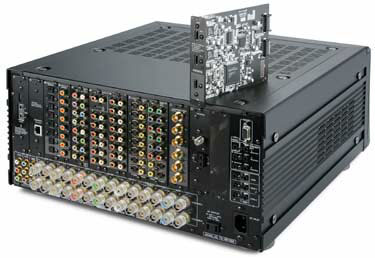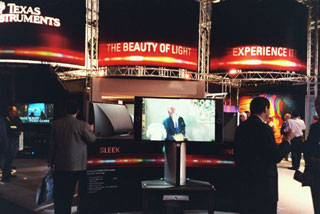Las Vegas, Nevada, January 2004 -- I'd barely shed my scarf and sheepskin from the frigid Northeast winter to accommodate the warm Las Vegas desert temperatures than Toshiba summoned us to a press event to demo a prototype High-Definition DVD player (and recorder) that may well become the future standard for HD-DVD. (So much for my new progressive-scan "Universal" DVD player that plays DVD-Audio and SACD discs. Will it play the proposed new high-definition DVDs? Nope.)
All kidding aside, it isn't surprising that an advanced higher-resolution DVD format was on the way, because Toshiba was one of the earliest co-developers and leading proponents of our current DVD standard. The Consumer Electronics industry is characterized by nothing if not constant change and innovation, so it is only logical that as new HDTV direct-view, rear and front-projection sets proliferate and prices come down, a new optical disc video standard was in the offing. With most consumers moving to larger screen sizes, the desire for movies and programs of extreme clarity that exploit the full capabilities of HD displays will only increase.
Lest you think that "Toshiba has gone and made my gear obsolete," there is some reassurance in that Toshiba's new HD-DVD player is a prototype, and it takes time for industry giants to agree on criteria. Still, the proposed Toshiba HD standard argues for quick industry acceptance because it uses a single-lens dual-beam optical reader that integrates both a red-laser diode for reading standard DVDs (thus ensuring compatibility with your existing library of DVD movies), and a blue-laser diode for the new HD-DVDs. And because the new HD DVD disc employs the same disc structure as current DVDs, manufacturers will be able to utilize existing production equipment to press the new discs without making huge investments.
The dual-layer single-sided read-only disc will have a large 30-gigabyte capacity (current DVDs store 4.7 GB.) and will store over two hours of high-definition movie content. Remarkably, the length of a "pit" engraved on an HD-DVD is just 0.2 micrometers, approximately 25% the length of the 0.8-um pit on an audio CD. This necessitated development of the special blue laser to read the HD-DVD's microscopic pits.
Still on the video beat, flat-panel HDTV plasma and LCD screens were everywhere, and getting bigger: Zenith and its parent company, Korea-based LG Electronics, announced a 76-inch diagonal HDTV 1080p native plasma display and a 55-inch wide LCD panel, also of HDTV resolution. Panasonic exhibited rows of its new Viera flat-panel plasma and LCD displays, many now fully integrated HDTVs equipped with CableCARD slots that allow viewers to receive both HDTV and standard definition digital programming, including HBO, without the need of an outboard digital HD set-top box. Since there are 70 million North American households wired to cable, the development of integrated HDTVs with CableCARD slots will spur adoption of HDTV by cable customers as well as simplifying hookup.

Texas Instruments' booth had a variety of DLP rear-projection HDTVs, including the pedestal Samsung in the foreground that uses the latest TI xHD3 chip that displays a native 1080p HDTV picture.
Texas Instruments (TI), the inventor of the original Digital Light Processing (DLP) chip that has made state-of-the-art large-screen HD projection technology affordable and compact, introduced a series of new DMM (Digital Micro-Mirror) DLP chips that are said to yield enhancements in contrast, smoothness, and resolution over the existing HD2 chip, the latter commonly found in current DLP rear and front projectors. Two new Samsung pedestal-mounted (50- and 56-inch diagonal) sets use the new HD2+ DLP chip with Dynamic Black, said to deliver a 3000:1 contrast ratio. Both sets utilize a vertically mounted DLP light engine, which reduces set depth to less than 13 inches.

A photo of the stunning contrast and clarity delivered by Samsung's new pedestal mounted 55-inch diagonal DLP rear-projection set that uses the new TI HD+ DLP chip with Dynamic Black. The set won an Innovations 2004 Award at CES.
Samsung's new HD3 lineup of DLP rear-projection models (46-, 50-, 56-, and 61-inch screens; the 43-inch is gone) uses an HD3 chip utilizing DarkChip2 and SmoothPicture technology with a contrast ratio of 1500:1. While examples of these were very impressive, the real stunner was a new Samsung 56-inch DLP rear-pro set that uses TI's latest xHD3 chip. Showcased at the TI booth, which was always crowded, the xHD3 incorporates all the aforementioned technologies but delivers native 1080p resolution (the HD2 chips deliver 720p). To these eyes, this set had the best picture at CES and the most impressive HD video I've ever seen. A TI spokesman told me that the new Samsung set will likely sell in the $5000+ range when it appears later this year. Not cheap, but still a relative bargain compared to the $20,000 prices of heavy, bulky high-end CRT HD projectors that were the ultimate just a few years ago.
Other DLP sets have dramatically reduced their waistlines, with Thomson (RCA) showing two new models just 6.8 inches thick, the latter achieved by using a vertical DLP light engine developed by InFocus. The ultra-slim DLP RCAs are fully integrated HDTVs with CableCARD slots, and looked very good, but perhaps not quite the equal of RCA's regular Scenium DLP rear-pro sets of more conventional DLP dimensions. (Confused about all the formats? Refer back to our handy "Choosing a Large-Screen TV Display" Guide.)
Because of chip shortages, manufacturing difficulties, and costs, Toshiba announced that it had stopped development of its much-touted Liquid Crystal on Silicon (LCoS) displays in favor of an entire new line of as many as ten DLP sets slated for introduction later this year. In theory, LCoS displays offer many, but not all, the advantages claimed for DLP sets. While my past exposure to LCoS rear-projection sets has been limited, I never found the LCoS picture to quite equal that of the best DLP displays. The LCoS picture seemed to lack the deep blacks and contrast of DLP and evidenced a touch of graininess.
Microsoft inched closer to Consumer Electronics turf by showing a Windows Media Center that you hook up near your A/V system and TV display. It is then networked (wired or wireless) throughout a home via the home Media Center PC. Sound complicated? You bet, and I'm not at all convinced that merging these technologies makes sense in a lot of homes, but Bill Gates (helped at the show by Jay Leno) thinks otherwise. But hey - Bill Gates once famously thought no one would need more than 64 k of memory, right? Microsoft also demonstrated a video HD codec that supports 720p and 1080p High Definition. It uses a fairly narrow bandwidth and would like to be a contender for HD-DVD.
Flagship audio-video (A/V) receivers, predictably, are mostly getting larger and more expensive, some adding useful features, others with functions of somewhat dubious utility. Some of the more interesting entries include Harman/Kardon's AVR 7300, which has a built-in Faroudja DCDi video scaler and deinterlacer, which up-converts connected analog video sources such as VCRs, interlaced DVD players, and analog cable to 480p progressive-scan video with claimed "extraordinary" video quality. Suggested retail of the 7.1-channel 7300 is $2,199.

Onkyo's new $4,000US TX-NR1000 flagship A/V receiver uses card-based plug-in circuit modules like a computer, which customers can specify in advance or order later on to incorporate new technologies.
In order to thwart future obsolescence, Onkyo has applied computer modular architecture to its new TX-NR1000 receiver, which uses card-based plug-in circuit modules and a build-to-order marketing approach. The customer chooses which of nine A/V modules he wants his receiver equipped with (AM/FM tuner, digital radio, component video in/out, HDMI, etc.) and as new ones become available, customers can choose to expand. The TX-NR1000 claims seven channels at 150 watts per channel into 8 ohms. (Erudite Axiomites know that such power ratings are - ahem - often measured with just one or two channels driven at full power and the others at a fraction of the power output.) It will be available in April at $4,000. (By the way, HDMI--high-definition media interface--is the latest high-resolution connector that will eventually replace DVI, the complicated multi-pin connector now used for digital video. HDMI will be a simpler USB-like connector carrying HD digital video as well as 5.1-channel digital audio, simplifying connection and switching of high-resolution A/V components and TV displays.)
Denon's new AVR-3805, which replaces its best-selling 3803, adds an integral 8-band digital parametric room equalizer with auto calibration and setup of channel level and time delay, speaker connection and phase, size, and frequency response. Claiming 120 watts into 8 ohms for each of its seven channels, the 3805 also has Dolby Pro Logic IIx (DPLII "x" decodes 2-channel stereo into as many as 7.1 channels). The suggested US retail is $1,200. Denon's flagship THX Ultra2-certified 5803 ($4,400) continues mostly unchanged but for the addition of DPLIIx and HDCD decoding.
(Editorial note: Although I didn't receive a demo of the AVR-3805, it's worth noting that doing accurate measurements of listening-room frequency response aberrations is extremely complex, and correcting for room response errors using 8 bands of parametric digital EQ is essentially impossible. At worst, such digital auto-correction schemes have the potential of making good speakers sound bad by "correcting" the frequency response of an otherwise neutral, linear well-designed speaker. Users may mistakenly interpret small level increases introduced by the auto-EQ system as sounding "better," a common result of uncontrolled listening. I would advise enthusiasts to take these auto-EQ systems with a liberal dose of salt, and not base purchasing decisions on this particular feature.)
Also impressive in its meticulous craftsmanship and alleged audio superiority (alleged by others; I've not heard it), Arcam has always represented thoughtful British design at its best. Arcam's new FMJ AV8 A/V preamp-processor lacks for nothing: it handles all the digital formats, DPLIIx, THX Ultra2 certification, 2nd zone operation, and HD component-video inputs. Paired with its companion FMJ P7 seven-channel power amplifier (150 watts per channel into 8 ohms, all channels driven, 20 Hz - 20 kHz; 230 watts per channel into 4 ohms), the combo will set you back a tidy $9,600.
Loudspeakers, naturally, came in all shapes, sizes, and technologies, although the cone-and-dome towers seemed more dominant than ever over planar flat panels. As I toured the relaxed rooms of the Alexis Park Hotel (a boutique hotel with central courtyards, swimming pools and park-like settings), I heard music reproduction in all stripes from huge towers to flat panels with ribbons and other odd planar drivers. Truth be told, I'd tell you if the sound were transcendent, but it wasn't. Transparency and neutrality are still the criteria for accurate instrumental and vocal reproduction, and I heard no speakers that exceeded the best of Axiom's lineup in that regard, and many that were disappointing with stratospheric prices. In all cases, multichannel music reproduction with neutral speakers continues to deliver rewards in realism over esoteric, high-end 2-channel systems.







